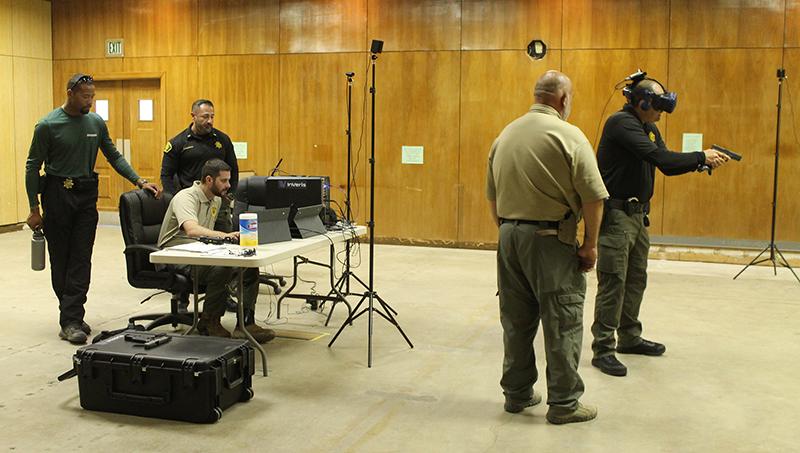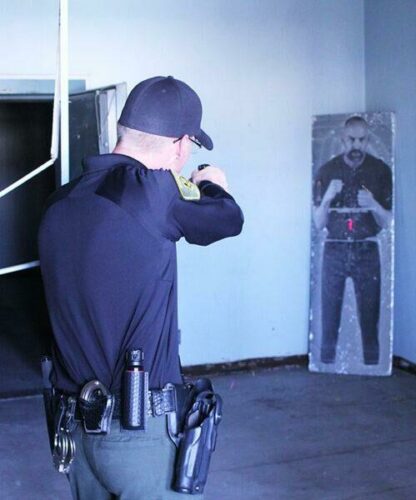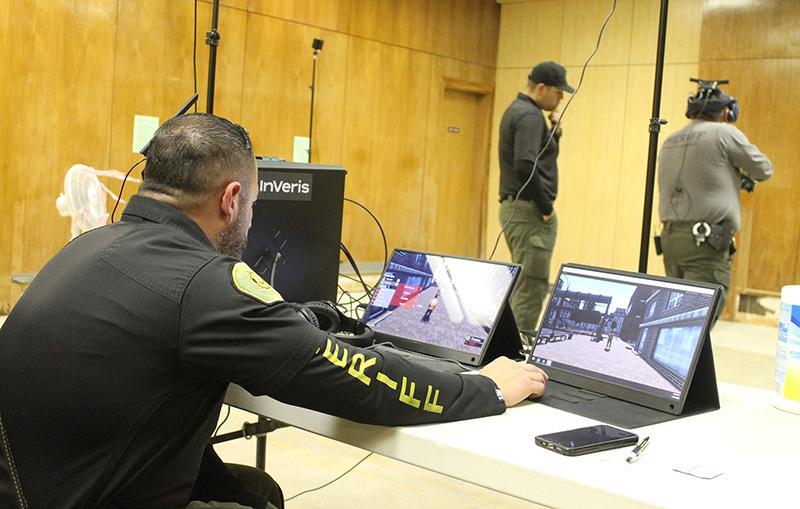Julia M. Dendinger | News-Bulletin photos
Valencia County Sheriff’s Office training coordinator Lt. Pete Alderete controls the suspect, on the left screen, during a virtual-reality training for deputies. The monitor on the right shows what VCSO Detective Porfie Baca, far right, sees through the VR goggles. Sgt. Victor Duran is the safety officer during Baca’s training session, to ensure the detective doesn’t become disoriented.
One local law enforcement agency is introducing its officers to the world of virtual reality training.
Last month, deputies with the Valencia County Sheriff’s Office spent the day in annual training, which started with the typical classroom-and-lecture format, then progressed to taser exercises and finished with brand new technology that dropped them into a virtual world.
VCSO Lt. Pete Alderete, the office’s training coordinator, said he began looking for new training tools last year in an effort to keep officers engaged and excited about annual training.
“It’s the latest and greatest, something we’ve never had before and most of us haven’t experienced,” Alderete said of the virtual system. “We’re always looking for the best way to train our guys.”
The $30,000 package includes the software for the system, which allows for recording and playback of scenarios, as well as the hardware that sends the VR environment to a wearer’s headgear, in addition to several pieces of equipment that bring reality to the virtual, such as handguns, a taser, pepper spray, flashlight and an M4, AR-15 type rifle. None of the mock weapons shoot projectiles, electrical leads or a chemical spray.
In the past, officers have participated in force-on-force training that involves real people portraying victims and suspects in a staged area, but Alderete said that kind of hands-on scenario is resource and time intensive.
“With the virtual system, it can be me, a safety monitor and one officer, and we can run through training scenarios,” he said.

Valencia County Sheriff’s Office Detective Rashad Pearson and Lt. Pete Alderete watch as Det. Ben Lankasky runs a virtual reality training session for Sgt. Victor Duran, far right. Det. Sgt. Dave Zilink is the safety officer for Duran. While the officer is in the VR scenario, they cannot see other people and objects in the room.
When an officer is in the virtual environment, a safety officer is physically present to make sure they don’t become disoriented. The system puts up a bright, blue grid that’s visible in the scenario when an officer gets to close to the perimeter created by the VR sensors. In complex environments, such as a building with multiple rooms, a green dot or other signifier appears to let an officer know they can go through a door or up a stairwell to access other ares of the scenario.
The system comes pre-programmed with dozens of scenarios officers might encounter in the real world — from traffic stops to domestic violence calls, mass shootings and searching for a suspect in a massive, multi-story building.
On the day of the training, deputies were put into two scenarios. The first, they had to convince a person not to jump off a bridge and, in the second, they had to deal with a man on the street, threatening people in the area.
In both scenarios, the officers focused on de-escalating the situation and trying to use a reasonable amount of force. The VR headgear consists of a visor that shows the officer the scene and earphones that bring in ambient sounds as well as the voice of the person they’re talking to.
The program has prerecorded responses a training officer can select to respond to questions and commands from the officer. There’s also the option to manually speak to the officer in the training using a microphone.
“The trainer can say exactly what he needs to so it’s not so scripted,” Alderete said. “That way they avoid the whole cookie-cutter answers and responses.”
The instructor also controls the movement of the “person” the officer engages with, deciding if they will put their hands up, charge the officer or, in one unfortunate instance, jump off the bridge.
The VR setting allows officers to use their training and lets instructors know whether the training is sticking. Alderete said keeping the public and officers safe is paramount.
“This lets them review what happened. We did have one deputy fail the bridge scenario, and we had him do it again. I told him, ‘Remember your training,’” Alderete said.

In addition to the virtual reality training, Valencia County Sheriff’s deputy Cody Maycumber and other deputies participated in live taser training last month during the department’s annual training.
In the second run through, instead of repeatedly giving the virtual person commands to drop the knife, the officer built rapport, asked his name, and if he was OK, the lieutenant said.
“I think being able to have that redo in virtual, to remember your training, is a huge benefit,” he said. “
After a VR scenario, officers are debriefed by the instructors immediately, which reinforces what they did well and where they need to improve, Alderete said.
“They’ve been very receptive to the debrief and feedback,” he said. “They know with the training we’re providing, we’re only there to help them.”
Alderete said the VCSO trainers work collaboratively to improve officers’ skills, and the immersion of the VR will hopefully keep them interested and push them to keep improving.
“By starting in the classroom, then moving to the more hands-on aspects, they can retain it better,” he said.
VCSO Undersheriff Jeff Noah said in his opinion, the department’s training program for de-escalation and use of force is way above those of a lot of other departments.
“Not only in the state but across the country. We built this program and the VR is just expanding it and making it a little bit more,” Noah said. “With new recommendations coming out, we need to add more training time but we are pushing the amount of time we have with our guys already.”
The undersheriff echoed Alderete’s observation that having the virtual system will allow training with less manpower and expense.
“Just us three can run it right now, and do an hour of training, really get immersed in there,” he said. “If you think about it that way, that’s a real cost benefit.”
Both Alderete and Noah said the department would be more than willing to let other agencies use the system to train their officers, and Alderete noted there are specific training modules for court security officers and ones that would benefit school resource officers.
“Ultimately, I hope we’re showing the public we’re continuing to grow and continuing to educate our guys,” Alderete said.
Julia M. Dendinger began working at the VCNB in 2006. She covers Valencia County government, Belen Consolidated Schools and the village of Bosque Farms. She is a member of the Society of Professional Journalists Rio Grande chapter’s board of directors.

















